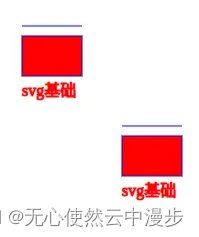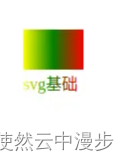上一篇文章简单介绍了svg常用标签及其属性,本篇主要介绍分组,渐变
1 分组<g>
分组容器
- 添加到g元素上的变换会应用到其所有的子元素上
- 添加到g元素的属性会被其所有的子元素继承
- 定义复杂对象,可通过<use>元素引用
1.1 分组
<svg><g><line x1="20" y1="20" x2="80" y2="20" stroke="blue" /><rect x="20" y="30" height="40" width="60" stroke="blue" fill="red" /><text x="20" y="90" stroke="red" fill="red">svg基础</text></g>
</svg>

1.2 继承属性
<svg><g stroke="blue"><line x1="20" y1="20" x2="80" y2="20" /><rect x="20" y="30" height="40" width="60" fill="red" /><text x="20" y="90" stroke="red" fill="red">svg基础</text></g>
</svg>

1.3 应用变换
<svg><g stroke="blue" transform="rotate(30,50,50)"><line x1="20" y1="20" x2="80" y2="20" /><rect x="20" y="30" height="40" width="60" fill="red" /><text x="20" y="90" stroke="red" fill="red">svg基础</text></g>
</svg>

可以看到,<g>元素中的所有形状如何围绕点50,50旋转30度
可以看到line和rect继承了g的stroke,而text应用的是自身的stroke
<g>标签没有X和Y属性,意味着不能通过更改x和y属性来移动其中的元素。要移动<g>标签的内容,只能使用transform属性使用“ translate”函数
<svg width="300" height="300"><g stroke="blue"><line x1="20" y1="20" x2="80" y2="20" /><rect x="20" y="30" height="40" width="60" fill="red" /><text x="20" y="90" stroke="red" fill="red">svg基础</text></g><g stroke="blue" transform="translate(100,100)"><line x1="20" y1="20" x2="80" y2="20" /><rect x="20" y="30" height="40" width="60" fill="red" /><text x="20" y="90" stroke="red" fill="red">svg基础</text></g>
</svg>

2 渐变
渐变标签必须嵌套在<defs>标签内部
2.1 线型渐变<linearGradient>
线性渐变可以定义为水平,垂直或角渐变:
- 当y1和y2相等,而x1和x2不同时,可创建水平渐变
- 当x1和x2相等,而y1和y2不同时,可创建垂直渐变
- 当x1和x2不同,且y1和y2不同时,可创建角形渐变
<svg><defs><linearGradient id="lineGrad1" x1="0%" y1="0%" x2="100%" y2="0%"><stop offset="0%" stop-color="yellow" stop-opacity="1" /><stop offset="50%" stop-color="green" stop-opacity="1" /><stop offset="100%" stop-color="red" stop-opacity="1" /></linearGradient></defs><rect x="20" y="30" height="40" width="60" fill="url(#lineGrad1)" /><text x="20" y="90" fill="url(#lineGrad1)">svg基础</text>
</svg>

<svg><defs><linearGradient id="lineGrad1" x1="0%" y1="0%" x2="0%" y2="100%"><stop offset="0%" stop-color="yellow" stop-opacity="1" /><stop offset="50%" stop-color="green" stop-opacity="1" /><stop offset="100%" stop-color="red" stop-opacity="1" /></linearGradient></defs><rect x="20" y="30" height="40" width="60" fill="url(#lineGrad1)" /><text x="20" y="90" stroke="url(#lineGrad1)">svg基础</text>
</svg>

<svg><defs><linearGradient id="lineGrad1" x1="0%" y1="0%" x2="100%" y2="100%"><stop offset="0%" stop-color="yellow" stop-opacity="1" /><stop offset="50%" stop-color="green" stop-opacity="1" /><stop offset="100%" stop-color="red" stop-opacity="1" /></linearGradient></defs><rect x="20" y="30" height="40" width="60" fill="url(#lineGrad1)" /><text x="20" y="90" stroke="url(#lineGrad1)">svg基础</text>
</svg>

2.1 放射性渐变<radialGradient>
- CX,CY和r属性定义的最外层圆和Fx和Fy定义的最内层圆
- 渐变颜色范围可以由两个或两个以上的颜色组成。每种颜色用一个<stop>标签指定。offset属性用来定义渐变色开始和结束
<svg><defs><radialGradientid="radialGrad2"cx="50%"cy="50%"r="50%"fx="50%"fy="50%"><stop offset="0%" stop-color="white" stop-opacity="0" /><stop offset="100%" stop-color="blue" stop-opacity="1" /></radialGradient></defs><rect x="20" y="30" height="40" width="60" fill="url(#radialGrad2)" /><text x="20" y="90" stroke="url(#radialGrad2)">svg基础</text></svg>





)
(二))
 【计算机硬件系统设计】)





)






15.9 编程练习 第3题)